-
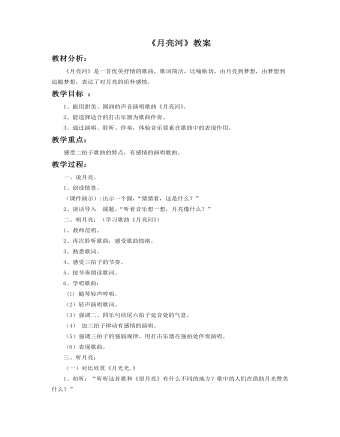
《月亮河》教案
教学过程:一、说月亮。1、创设情景。(课件演示):出示一个圆,“猜猜看,这是什么?”2、谈话导入 课题。“听着音乐想一想,月亮像什么?”二、唱月亮:(学习歌曲《月亮河》)1、教师范唱。2、再次聆听歌曲,感受歌曲情绪。3、熟悉歌词。4、感受三拍子的节奏。5、按节奏朗读歌词。6、学唱歌曲:(1) 随琴轻声哼唱。(2)轻声演唱歌词。(3)强调二、四乐句结尾六拍子延音处的气息。(4) 加三拍子律动有感情的演唱。(5)强调三拍子的强弱规律,用打击乐器在强拍处伴奏演唱。(6)表现歌曲。三、听月亮:(一)对比欣赏《月光光.》1、初听:“听听这首歌和《望月亮》有什么不同的地方?歌中的人们在借助月光赞美什么?”2、自己选择合适的打击乐为歌曲伴奏。(二)听赏《月亮河边的孩子》。1、感受三拍子歌曲的特点,“听听这首歌和《望月亮》有什么相似的地方。”2、总结三拍子歌曲特点和演唱情绪。

《智斗》教案
教学过程:(一)导入新课。1、欣赏歌曲《唱脸谱》。设问:刚才我们听到的歌曲与以往听到的歌曲有什么不同?你在什么地方听到过京剧?你知道哪些关于京剧的知识?导入:京剧是我国的国粹,迄今已有200多年的历史。它是第一个走向国际舞台的,代表中华民族的表演艺术。所以我认为作为中国人,有必要了解一下自己的国宝——我们的京剧艺术。(二)新课教学。1、欣赏京剧《智斗》(现代京剧《沙家浜》选段)。a。简介人物身份、故事情节后听赏《智斗》。b。这三个人物之间的关系?这三个人物在剧中的性格形象分别有什么特点?(1)唱腔:西皮。反西皮 :是[西皮]声腔的一种曲调,它是从[西皮]正调中演生出来的。是正[西皮]的反调,即向下四度发展转化而成。[反西皮]和[西皮]一样大多是"眼起板落",开唱在眼上,末句落在板上。请注意:[反西皮]的下句落音往往是低音5和中音1,和[西皮]相比,音调较低沉,常常用于表现人物内心思索的过程。(2)板式:摇板(紧拉慢唱)。流水板(一拍子):流水板就是一种形似流水一样的板式,节奏比较快,但不是像波涛滚滚的长江那样跌宕起伏,而是像水流平缓的涓涓小溪,用快而不急的节奏,把人物的内心感情抒发出来,多用于对事物的叙述和自我表白。比流水板节奏更加快的,则是“快板”。快板用于剧中人物异常激动,或事态急剧变化,或矛盾瞬间变得激烈时,往往把剧情引向高潮。

《走绛州》教案
一、走进西部1.歌声引进西部。2.影片简介西部。课件展示黄河、黄土高坡以及黄土高原上人们的生活。介绍西部的地理环境和风土人情,了解它们与当地的音乐之间千丝万缕的联系。二、西部放歌1.听《黄河船夫曲》(l)聆听(2)跟唱(3)表演师:拉船的人就叫纤夫,你们带的毛巾可以派上用场了吗?怎么做才像是在一根绳上拉船呢?2.唱《走绛州》(1)过渡语船靠岸了,船夫们坐下休息休息。高原上随处都能听到悠扬的歌声。你听,那边船夫的歌声刚落,这边又传来孩子们学唱的挑夫的歌!(2)听听《走绛州》师:同样是来自黄土高原上的民歌,它们的风格有什么不同呢?生:……师:你从歌曲中听到了些什么?生:一根扁担软溜溜,担上扁担到绛州……(3)说说“走绛州”师:对,歌中唱到“担上扁担走绛州”,“绛州”在哪里?为什么要“走绛州”而不是“坐车到绛州”?生:……师:“绛州”是古称,在今天的山西省新绛县,明、清时期,这里是商业发达的繁华之地。我们现在要买东西都是拿钱到超市去买。可那时候高原上沟壑纵横,交通不便,人们要买东西、卖东西都只能挑着担子走到绛州去。于是就有了“担上扁担走绛州”的说法。
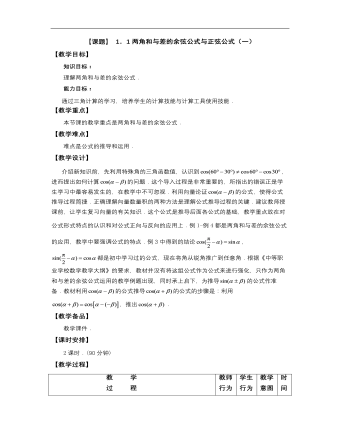
【高教版】中职数学拓展模块:1.1《两角和与差的正弦公式与余弦公式》教案
教 学 过 程教师 行为学生 行为教学 意图时间 *揭示课题 1.1两角和与差的余弦公式与正弦公式. *创设情境 兴趣导入 问题 我们知道,显然 由此可知 介绍 播放 课件 质疑 了解 观看 课件 思考 引导 启发学生得出结果 0 10*动脑思考 探索新知 在单位圆(如上图)中,设向量、与x轴正半轴的夹角分别为和,则点A的坐标为(),点B的坐标为(). 因此向量,向量,且,. 于是 ,又 , 所以 . (1) 又 (2) 利用诱导公式可以证明,(1)、(2)两式对任意角都成立(证明略).由此得到两角和与差的余弦公式 (1.1) (1.2) 公式(1.1)反映了的余弦函数与,的三角函数值之间的关系;公式(1.2)反映了的余弦函数与,的三角函数值之间的关系. 总结 归纳 仔细 分析 讲解 关键 词语 思考 理解 记忆 启发引导学生发现解决问题的方法 25
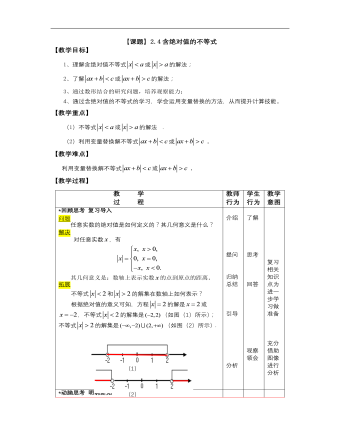
【高教版】中职数学基础模块上册:2.4《含绝对值的不等式》优秀教案
【教学目标】1、理解含绝对值不等式或的解法;2、了解或的解法;3、通过数形结合的研究问题,培养观察能力;4、通过含绝对值的不等式的学习,学会运用变量替换的方法,从而提升计算技能。【教学重点】(1)不等式或的解法.(2)利用变量替换解不等式或.【教学难点】 利用变量替换解不等式或.【教学过程】 教 学 过 程教师 行为学生 行为教学 意图 *回顾思考 复习导入 问题 任意实数的绝对值是如何定义的?其几何意义是什么? 解决 对任意实数,有 其几何意义是:数轴上表示实数的点到原点的距离. 拓展 不等式和的解集在数轴上如何表示? 根据绝对值的意义可知,方程的解是或,不等式的解集是(如图(1)所示);不等式的解集是(如图(2)所示). 介绍 提问 归纳总结 引导 分析 了解 思考 回答 观察 领会 复习 相关 知识 点为 进一 步学 习做 准备 充分 借助 图像 进行 分析
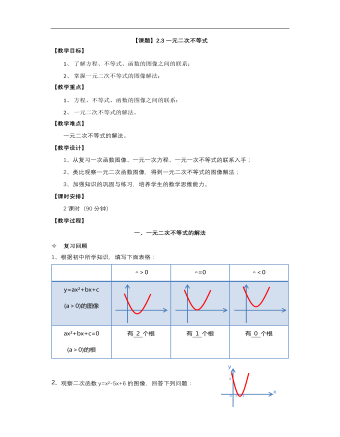
【高教版】中职数学基础模块上册:2.3《一元二次不等式》优秀教案
【教学目标】1、了解方程、不等式、函数的图像之间的联系;2、掌握一元二次不等式的图像解法;【教学重点】1、 方程、不等式、函数的图像之间的联系;2、 一元二次不等式的解法。【教学难点】 一元二次不等式的解法。【教学设计】 1、从复习一次函数图像、一元一次方程、一元一次不等式的联系入手;2、类比观察一元二次函数图像,得到一元二次不等式的图像解法;3、加强知识的巩固与练习,培养学生的数学思维能力。【课时安排】 2课时(90分钟)【教学过程】一、一元二次不等式的解法² 复习回顾1、根据初中所学知识,填写下面表格: △>0 △=0△<0y=ax²+bx+c (a>0)的图像ax²+bx+c=0 (a>0)的根有 2 个根有 1 个根有 0 个根2、观察二次函数y=x²-5x+6的图像,回答下列问题:(1)当y=0时,x取什么值?(2)二次函数y=x²-5x+6的图像与x轴交点的坐标是什么?(3)当y<0时,x的取值范围是什么?总结:由此看到,通过对函数y=x²-5x+6的图像的研究,可以求出不等式x²-5x+6>0与x²-5x+6<0的解集
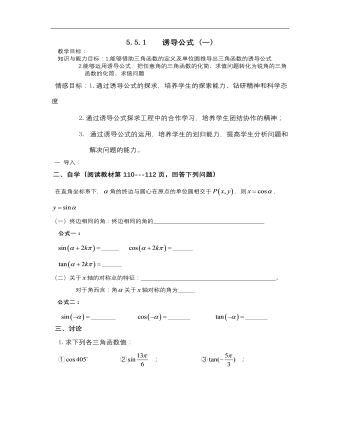
【高教版】中职数学基础模块上册:5.5《诱导公式》优秀教案
教学目标:知识与能力目标:1.能够借助三角函数的定义及单位圆推导出三角函数的诱导公式 2.能够运用诱导公式,把任意角的三角函数的化简、求值问题转化为锐角的三角函数的化简、求值问题情感目标:1.通过诱导公式的探求,培养学生的探索能力、钻研精神和科学态度 2.通过诱导公式探求工程中的合作学习,培养学生团结协作的精神; 3. 通过诱导公式的运用,培养学生的划归能力,提高学生分析问题和解决问题的能力。 一导入:二、自学(阅读教材第110---112页,回答下列问题) 在直角坐标系下,角的终边与圆心在原点的单位圆相交于,则,(一)终边相同的角:终边相同的角的 公式一:_______ ________________(二)关于轴的对称点的特征: 。对于角而言:角关于轴对称的角为_______公式二:__________ _________ _________
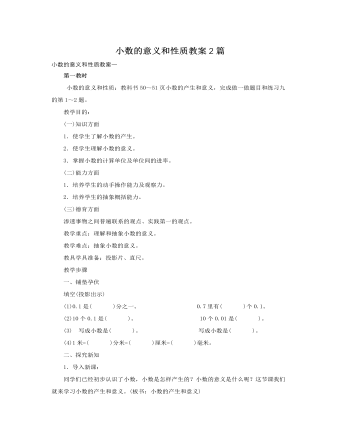
人教版新课标小学数学四年级下册小数的意义和性质教案2篇
用米作单位,用分数怎么表示呢?(1/10米)师:1/10米也可以写成0.1米。师:请同学们看米尺,从0到30,从0到70,应该是几分米,十分之几米?用小数怎样表示呢?可先和同桌商量商量。学生同桌讨论后反馈师根据反馈结果提问:请同学观察一下1/10米和0.1米,3/10米和0.3米,7/10米和0.7米之间有什么关系?随学生的回答出示1/10米=0.1米 3/10米=0.3米 7/10米=0.7米。再让学生观察上面的等式,四人小组讨论你发现了什么?使学生通过讨论明确:分母是10的分数可以写成一位小数,一位小数表示十分之几。2、 认识两位小数 、三位小数师:我们已经知道了一位小数表示十分之几,那么请同学猜一猜两位小数与什么样的分数有关?三位小数与什么样的分数有关?(具体的步骤和前面相似)让学生根据一位小数表示十分之几,猜想出两位小数和什么样的分数有关?有意识地促进“迁移”,使学生在学会的同时学习能力也得到提高。关于计数单位的教学我个人认为还是放到52页小数数位顺序表这里教学比较妥当。
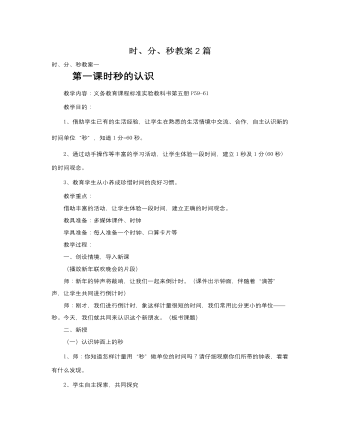
人教版新课标小学数学三年级上册时、分、秒教案2篇
教学目的:1、通过贴近学生生活实际的素材,在丰富多彩的实践活动中充分体会时、分、秒的实际意义。2、通过练习,学生比较熟练地进行一些简单的时间计算教学重、难点:时间单位的简单转换和求经过时间的方法。教学过程:第2题,先让学生独立完成,再让学生说一说每一题是怎么比较的,允许学生用不同的方法进行比较,只要说得有道理就行。第3题,读读书上的三个例子,并要求学生收集类似的信息。第4、5题,学生计算经过的时间。如果部分学生有困难,让他们借助钟面模型加以演示、理解,教师给予适当的帮助。第6题,要求学生先估计,再实际进行验证,验证的数据可以由学生和家长一起完成。第7题,事先让学生找几个自己感兴趣的节目,想办法把它们开始和结束的时刻都记录下来。

人教版新目标初中英语七年级下册How was your weekend教案2篇
Teaching Goal:1. General aims:Talk about recent past events2. Particular aims:A. Language Focus.Talk about recent past events and think of the past events.B. Language goalsHow was….?It was …What did …do over the weekend?C. Language structures:(1). How was your weekend? I was great. Pay attention to no form.(2). What did you do over the weekend? I played soccer. We went to the beach.D. Useful words and phrases:Words: was, did, went, beach, over, project, test, wasn’t, false, number, geography, spend, week, most, mixture, their, had, little, cook, read, saw, change, everyone, sit, sat, no, anythingPhrases: did one’s homework, played soccer, cleaned my room, went to the beach, played tennis, went to the movies, on Saturday morning, over the weekend, cook … for, what about, do some reading, have a party, talk show, go shoppingE. Grammar language:Present simple past tenseRegular and irregular verbsF. Learning strategies:Tour and holidaysG. Interdiscipinary:H. Emotion and manner:Teaching time: 5 periodsTeaching procedures:Period One教学步骤、时间 教师活动 学生活动 媒体应用Step 1Free talk 3’ Ask some questions like:Who’s on duty today?What’s the weather like? Answer and talk about something.让同学们回答下列问题1. Do you like weekend? (Let some students answer)It takes them three minutes to talk about the question.2. Why do you like weekend? (let the students answer) Most of the students like the weekend此时教师用汉语问:“在周末期间问你干了什么?这句话用英语这么回答?Let the students guess.At last the teacher give them right answer3. What did you do over the weekend?(板书、学习)

人教版新目标初中英语七年级下册Don’t eat in class教案2篇
Don’t fight. =You can’t fight. (板书,教读)教师把这些句子板书在黑板上,并请学生大声整齐地读祈使句和“can’t”句型,并让学生注意两种句型表达形式的不同和转换,“Don’t …=You can’t…”;并对学生说:These are our school rules. (板书,教读) You can’t break the school rules. Don’t break the school rules.(板书,教读)步骤3 :Practicea. T: Now, each of the students is breaking one of these rules.Please finish 1a.学生看图,完成1a的内容,检查答案并大声朗读校规。b. 听录音,完成1b,选出四位学生都违反了哪条校规;听之前,学生要读会英文名。c. 请两位学生朗读1c部分的句型;要求学生两人一组对话表演,SA扮演外校转来新生,SB告知本校校规。(学生可经过讨论,多说出他们想到的校规,不必只限于书上;教师应给予帮助)2) 第二课时(2a~4)步骤1 :warming up of revisionT: What are the rules at your school?学生使用“can”或祈使句表达各条校规;其中老师可引出“eat in the cafeteria outside”的表达。步骤2 :Practicea.T: Christina is an exchange student. She doesn’t know the rules. Let’s listen, what activities they’re talking about?学生听第一遍时,完成2a;第二遍时,完成2b;b. 请学生领读2c部分,看着2a完成的表格,理解2c活动的要求;分成小组针对2a进行问答;

人教版新目标初中英语八年级上册How do you make a banana milk shake教案2篇
1. First, ... then, ... next, ... finally, ...首先,……然后,……接着,……最后,……这是英语中表达做某事的步骤的一种说法。如果步骤较多,还可以说:first-next-after that-later on-finally/at last通常你会听到说英语国家的人在说 first, next, then, finally 和后面的内容时,他们会做一些停顿。这样就能提前告诉听者接下来讲的是一系列的步骤。这一点在朗读和听力中应特别注意。2. how many, how much均为疑问词,同是“多少”,但用法不同。请看:how many修饰可数名词复数,how much修饰不可数名词。但在用法上,同学们常犯如下错误:1) [误] How many are there bananas on the table?[正] How many bananas are there on the table?[析] how many, how much 中的many,much是形容词,常修饰名词作定语,故后面跟名词。2) [误]How much tea are there on the table?[正]How much tea is there on the table?[析] how much修饰不可数名词时,谓语动词用单数。how many与how much的区别可简记为:前how many:问“多少”,复数名词后面跑;how much问“多少”,不可数名词单数好。前者答语用基数词,后者答语用数量关系。

人教版新目标初中英语八年级上册How was your school trip教案2篇
“Go for it!” is based on “Task-Based Language Teaching”. It adheres to “The authenticity principle”, “The form-function principle”, “The task dependency principle” and “The principle of learning by doing”. These principles all accord with the demands of curriculum focus.In and of Grade Seven (II), “Go for it!”, students have learned “The Simple Past Tense”. And it appears again in of Grade Eight (I). teaches students more about how to talk about events in the past. In addition, it gives affirmative and negative statements in the past tense, such as the sentence patterns “Did you see …?” “Were there …?” “Did you go …?” As the first part of Unit 8, Section A opens with a picture presenting the last school trip in the aquarium and continues with several step-by-step practice activities, which are all good for students to master “The Simple Past Tense”. Doing well in Section A will help students integrate the new target language with that in Section B. Thus, they can describe the events in the past freely and foster their own ability of reflecting and practicing. II. Teaching ObjectivesTeaching objective is the beginning and aim of teaching activities. According to the overall goal of the English elementary course--- improve students' synthetic ability of language application, which should be based on the development of students’ “Language knowledge”, “Language skills”, “Character building”, “Learning strategies” and “Cross-cultural awareness”. The teaching objectives are described as follows(I). Knowledge objectivesi. Master the simple past tense of regular and irregular verbsii. Recite the new words and expressions about the last school trip in the aquarium, including their pronunciation and intonation

人教版新目标初中英语八年级上册I’m more outgoing than my sister教案2篇
1 交通工具的比较此活动为小组活动。学生通过讨论找出到达某一城市可乘坐的各种交通工具,并选择最佳出行方式。Teacher:We’re going to Shanghai. How many ways can we use to get there? Yes, there are four ways: by bus, by plane, by train, by ship. Please discuss how you are going to get there.操作建议:(1)学生以小组为单位展开活动,谈论本组所选择的交通工具。(2)各组选代表向全班汇报,阐述本组所选择的交通工具的利和弊。完成任务所需要的语言结构:We can go there by ship. It’s more comfortable and cheaper than any other transportation.We can go there by bus. It’s cheaper but it takes longer time.2 哪个城市更合适?此活动具有挑战性。假设中国要举行2014年世界杯足球赛,分别从历史,人文,天气等方面对各城市(北京,大连,上海,昆明)进行比较,选择最佳举办城市。T: Imagine China is holding the 2014 FIFA World Cup. Which city do you think is the best for the World Cup, Beijing, Dalian, Shanghai or Kunming? Let’s work in groups. If you choose Beijing, please join the Team Red. If you chose Dalian, please join the Team White. If you choose Shanghai, please join the Team Blue. If you choose Kunming, please join the Team Green. Please show us its advantages. Then let’s see which team will win.

人教版新目标初中英语八年级上册What’s the best radio station教案2篇
教学重点和难点:运用所掌握的语言描述,比较不同地点的特点。在练习中学习掌握英语比较级和最高级的用法。课前准备分配小组,每组五至六人。通过上网或翻阅报刊杂志等方法,确定旅游线路,做出基本的旅游计划。教学设计:本节课流程图 学法指导:1.由于这是一堂新课,在教学中应注意面向全体,发挥学生的主体性,引导学生积极参与,激发学生的求知欲和学习积极性,指导学生积极思维,主动获取知识,养成良好的学习方法。逐步学会独立解决问题。总之要尽可能调动学生的非智力因素促进智力因素的发展。教法选择:1.电化教学法2.课堂讨论法3.任务型教学法采用这些方法的目的是为了充分调动学生的学习积极性,使学生变被动学习为主动学习。通过电脑形象的演示,加强印象,提高兴趣,突破难点,提高教学效率,进而增大教学的容量和信息量。充分体现教师为主导,学生为主体的教学原则。

人教版新目标初中英语八年级上册What’s the matter教案2篇
She shouldn’t go to the party tonight.Step7. TaskT: You know, there are lots of problems in our life. If you are a doctor, please tell us how to solve the problem. I will divide you into 9 groups. Please work in groups. And then choose one of you to report your ideas.The following are the problems:I have a toothache.I am hungry. I have a sore throat.I am stressed out. I have a sore back.I am tired. I can’t sleep.I have a cold. I have a headache.Report: If you have a headache, you should go to bed early. You should see the doctor. You should eat some medicine. You shouldn’t wash your face with cold water.You shouldn’t sleep late.You shouldn’t swim.…..T encourages the students to give advice as much as possible.Homework:1. Chose one of the problems, and write down your advice2. Copy the new words这一步是用于热身的,同时也可以让他们复习一部分的表示人体部位的单词,扩充知识.学习语言的过程也是一个不断积累的过程,复习旧知识,增添新知识.通过小游戏,强化学生对Does she/he have…这个句子的运用能力.通过复习,自然的引到下面新知识的学习。充分利用表格,由句子到对话,再到文章,让学生循序渐进. 提高学生的综合语言运用能力,运用以前学过的知识来解决身边的问题.Period 5 (Section B 3a—3c, selfcheck)教学内容与分析:

人教版新目标初中英语八年级下册He said I was hard-working教案2篇
This activity introduces some new vocabulary and provide oral practice using the target language.Task 1 . Ask four students to stand in front of the class, and the teacher asks them the following questions as a reporter.1.What are you going to do when you grow up?2.What are you going to do next week?3.What are going to do after school?The students will give different answers, then ask a good student to report what they said.I am going to e a doctor.What did she say?----------She said she was going to be a doctor.I am going to have a party on Friday night.What did he say?-------He said he was going to have a party on Friday night.I am going to do my homework.What did she say ?------ She said she was going to do her homework.I am going home after school.What did she say?-----She said she was going home after school.Say In this unit we are going to learn to use words like to report what someone said.Task 2. Read the instructions. Then ask a student to read the four questions. And write the words on the Bb. Explain what soap opera is.Task 3. Ask the students to Look at the pictures, point out the TV screens in the picture. Ask one girl to read what Marcia said.What did Marcia say? She said She said she was having a surprise party for Lana on Friday night. Repeat the other pictures in the same way.Activity3. Listen and number the pictures in activity 1a.

人教版新目标初中英语八年级下册What were you doing when the UFO arrived教案2篇
(一).知识方面: 1.培养学生能运用过去进行时来描述、谈论过去某个时间正在发生的事情或动作的意识和能力,能就过去某个时间正在发生的动作做出正确的描述。 2.培养学生的想象力和角色扮演的合作能力。 3.培养学生讲述过去发生的事情经过的能力。能正确运用一般过去时来讲述故事。 (二).技能方面: 1.本单元的语言目标是Talk about past events and tell a story(谈论过去的时间和讲述一个故事),围绕这一目标,要涉及句型: What were you doing when the UFO arrived? ----I was sitting in the barber’s chair. The barber was cutting my hair. 因此必须学习standing、studying、cleaning、sleeping、cooking、making、eating、cutting、等表示地点的词,以便为上述句型提供语言材料。2.学习过去进行时的有关知识。Was/were+现在分词,是该时态的表达式。 3.在学习过程中,要区分The boy was walking down the street when the UFO landed.和While the boy was walking down the street, the UFO landed.这两种由when和while引导的状语从句的句型结构。注意它们的不同。

人教版新目标初中英语九年级上册Teenagers should be allowed to choose their own clothes教案2篇
Step 1 Greeting Greet the class and check the homeworkStep 2 A duty report The S on duty gives a report on the rules in his home and lead in 3a “Sun Fei’s and Wu Yu’s rules” Step 3 ReadingSs read the conversation and write the two girls’ rules in the chart. Check the answers.Get Ss to read after the tape and then read aloud by themselves. Then, T explains the language points.Step 4 Pairwork 3bRole play. Use the information in chart to practice with the conversation in 3a covered. They can look at the sample conversation in the right box.Step 5 Task 2 “Who’s the best reporter?”Make a survey by asking any 5 students the questions in the chart in activity 4. Then give out a report about it. See who is the best reporter? And the best reporter will get a nice ball-pen.Step 6 Summary and homework:Write out the report in your exercise-books.Period ThreeStep 1 Greeting and a duty reportThe S gives a duty report talking about his experience of being late for school. Lead in the question “Do you ever get to school late? How often do you get to school late? Always, usually, sometimes, or never?Step 2 1a Get Ss to finish writing.Step 3 Pairwork 1b Get Ss to talk about their answers with their partners using the sample conversation in the box on the right.Step 4 Listening practice2a Lead-in: What will happen if you get to school late? What about Peter? Let’s listen to a conversation between Peter and his father. Get Ss to finish 2a (As usual, for the first time, Ss only listen.) Check the answers.

人教版新目标初中英语九年级下册We’re trying to save the manatees教案2篇
本单元主要围绕着有关濒临灭绝的动物这一话题,学习了应该怎样保护我们的环境,以及就某一问题展开辩论。目标提示语言目标能够运用所学知识,就某一问题展开辩论。认知目标1、复习一些语法:现在进行时、一般现在时、用used to 表示一般过去时、现在完成时、一般过去时的被动语态。2、学会表达同意和不同意。3、学会以下基本句型:We’re trying to save the manatees.Manatees eat about 100 pounds of food a day.There used to be a lot of manatees.In 1972,it was discovered that they were endangered.Some of the swamps have become polluted.情感目标了解一些濒临灭绝的动物的生活习性和濒临灭绝的原因,教育学生应该如何保护环境。教学提示充分利用多媒体等教学设备,创设与本课话题相关的情境,如各种不同种类的动物、动物园以及有关环境的画画等等。围绕着本单元的教学目标,设计一些贴近学生实际的教学任务,如让学生谈论自己最喜欢的动物,如何拯救濒危动物,如何保护环境等等。让学生根据所学知识,就动物园是否对动物有利以及其他的话题进行辩论。

